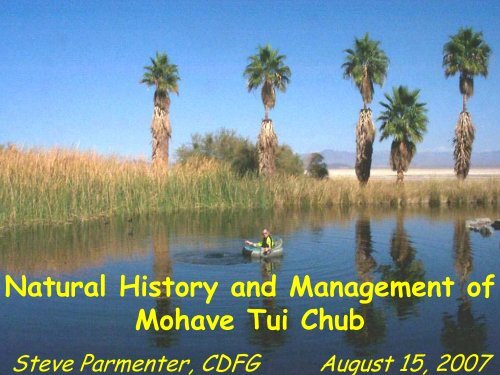Mojave Tui Chub CDFG
Mojave Tui Chub CDFG
Mojave Tui Chub CDFG
You also want an ePaper? Increase the reach of your titles
YUMPU automatically turns print PDFs into web optimized ePapers that Google loves.
Steve Parmenter, <strong>CDFG</strong> August 15, 2007Natural History and Management ofMohave <strong>Tui</strong> <strong>Chub</strong>
Phil Pister
Dr. Bernie MayUC Davis
Dr. Yongjiu Chen
tui chubs in general● Siphateles bicolor● western Great Basin minnow● omnivorous, schooling, fecund● long-lived● broad physiological tolerance● many are endangered
Portlandtui chubs<strong>Mojave</strong>
Great Basin:Quaternarycradle oftui chubevolutionLVLA
<strong>Tui</strong> chubsaccessOwens/DeathValley systemfrom the north,≥ 760,000 b.p.(?)Owens tui chubMohave tui chub
• Only native fish in <strong>Mojave</strong> River (extirpated)• Endangered 1971• One relict population “MC Spring”• 3 successful transplants
Historic DistributionOf Mohave tui chub
Q. So, what do these fishes need in life?A. Isolation….and water!
present distributionof Mohave tui chubCHINA LAKEMC SPRINGCAMP CADYLAKE TUENDAE
n=400, 1971n=75, 1976China LakeLark SeepM-C Spring??Lake Tuendaen=10, 1986n=55, 1987Camp Cadywest pond?Concrete tankn=59, 1987n>50001988Camp Cadyeast pondTransplanthistory ofMohave tui chubCamp Cadyfire pondpre1990n=1769, 1992Camp Cadywest pond
Importance of Genetic Variation• Fitnessdeclines with inbreeding• Persistence of species depends in part upon fitness• Maintaining evolutionary potential allowsadaptation to changed conditions (=remain fit)
Example: Florida Panther• Declined to 60-70 individuals• 10 % heterozygosity vs. ~45% in western US• Cowlicks, kinked tails and low fertility• 5 females introduced from Texas• 25 F1 offspring lack mutant phenotypes andappear more robust• Population tripled in size
Example: Devils Hole• An exposed aquifer surface in SW Nevada, with andendemic fish.• World’s smallest range for a vertebrate.• 1973 Landmark Supreme Court decision limitedgroundwater extraction & affirmed ESA.• Unexplained population decline from 400 to 80in 6 year period ending 2006.• Spring 2007 population is 24.
Genetic Questions• Are <strong>Mojave</strong> River populations hybrids not?• How much variation exists within and amongMTC populations?• Are there past or continuinglosses of diversity? .• .
Samples• Non-destructive fin clips• PCR Amplification• 4 refuge MTC populations + river + arroyo• 48 samples / site
Microsatellites are non-coding loci with ashort tandem repeating sequence:….TCTATCTATCTATCTATCTATCTATCTATCTATCTA……Example repeat unit“TCTA” from tui chubs
microsatellite DNA-Selectively neutral / rapid evolution-Bi-parentally inherited-Co-dominant- Variable: 65-90alleles/taxon, at 6 loci- Detect subtle variation among populations340bp300bp200bp
HYBRIDS?
Genetic DiversityPOP CC CL LT MC∑N A (∑N u ) 41 (0) 62 (6) 57 (4) 34 (1)R^± C.I. 0.67 ± 0.12 0.93 ± 0.06 0.88 ± 0.09 0.56 ± 0.17M^± C.I. 0.61 ± 0.12 0.70 ± 0.13 0.64 ± 0.15 0.65 ± 0.15H E^ 0.54 0.61 0.59 0.41
Population divergenceFC 2 (5.20%)One generationChina Lake + Tuendae±50 yearsCCCLLTMCCamp CadyFC 1 (7.89%)MC Spring
Loss of genetic variation inMohave tui chub• Mohave tui chub occur in 4 populations• 2 populations are robust; 2 are depauperate• Inbreeding and genetic drift• Possible “extinction” spiral• Reversible through managed immigration
number of fish35302520151050Lengths of Mohave <strong>Tui</strong> <strong>Chub</strong>, MC Spring, Oct. '05Census =634N e =?~2-5 g ~140 g20 30 40 50 60 70 80 90 100 110 120total lenth (mm)
Recommendations• Use both Lake Tuendaeand China Lake to foundadditional populations• Exchange individualsamong populations—and monitor.• Investigate the role of hybridization in speciesreplacement—can these species coexist?

















